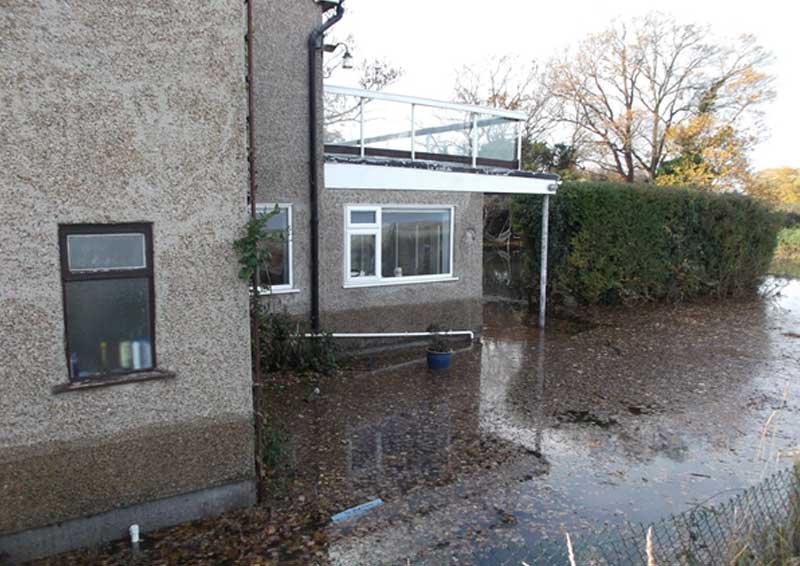Property flood resilience
In April 2017, CIWEM, ICE and RICS joined forces to call for a code of practice for the installation of property-level flood resilience measures to help householders and insurers avoid repeat flooding.
Contents |
[edit] Introduction
Currently, incomplete information about the type and quality of property flood resilience (PFR) increases the vulnerability of householders and insurers to flooding through poor quality PFR installations. Two building contractors alerted the Chartered Institution of Water and Environmental Management (CIWEM) to the existence of poor quality PRF installations. Simultaneous research by the Building Research Establishment (BRE) supported this view.
As a result, a coalition of leading civil engineers, water and environment management professionals and chartered surveyors are calling on the government to adopt a code of practice for the installation of PRF measures – or leave thousands of properties vulnerable to repeated flooding, wasting millions of pounds of taxpayers' and insurers' money.
Since the winter storms of 2015, when over 16,000 homes suffered flooding, properties flooded at that time have been able to apply for up to £5,000 of PFR funding. This comes from central government but is administered by local authorities. However, many PFR installations have been poor quality.
While DEFRA's Flood Resilience Action Plan (September 2016) calls for 'standards, training and skills', this newly-formed coalition want to go further. This week the coalition announced the creation of a steering group to oversee the Construction Industry Research and Information Association's (CIRIA) development of the PFR code of practice.
[edit] Clear unambiguous installation instructions
A code of practice would have three core advantages. First, it would provide clear unambiguous descriptions about what to do when installing PFR at each property, for contractors, engineers and surveyors on the one hand, and householders on the other.
A PFR code of practice would enable all stages in PFR installation, from assessment of the most appropriate type of PFR at the start of the process, to the creation of an insurance certificate about the PFR installed in a property at the end, to be performed to suitably high standards.
The code of practice needs to be not just a general guide but a chapter by chapter description of what contractors, engineers and surveyors need to do and an easily-understood description of what members of the public need to look for in terms of training, skill and insurances from PFR installers. The guide will be available for free on the internet when finished.
[edit] Effective coalition of leading built environment organisations
The second advantage of the proposed code of practice comes from the breadth and high standing of the built-environment coalition– CIWEM, ICE, and RICS – who collectively have the most direct responsibility for property flood protection.
By including civil engineering, water and environment managers and chartered surveyors in one group, the code of practice will have good standing in the built environment sector, can be rolled-out most effectively and include the unique needs of each professional group where appropriate.
[edit] Reliable and detailed risk information for insurers
The third advantage of the proposed code of practice is that it will provide reliable information for insurers about the type and quality of PFR measures that are installed in each property.
This will enable the insurance industry to assign market-based insurance costs to individual properties based on each property's flood risk and types of installed PRF, rather than being based on average estimations by flood-risk area. This will help align the incentives between property owners, contractors, engineers, surveyors, insurers and funders so that the most effective PFR measures are installed.
At present, it is impossible for insurers to estimate reasonable market costs for insuring each property. A code of practice and certification scheme would help develop market intelligence for the insurance industry, both for present needs and future needs after 2037, when the current insurance regime for at-risk properties (FloodRe) will end.
[edit] The benefits of a new built environment collaboration
Awareness of this issue, the seriousness with which the coalition is responding, and the proposed way forward, are all a testament to the strong relationships between contractors, engineering and surveying professionals.
Cross-professional working alerted us to the existence of the issue and will help us solve it. Working collaboratively with built environment professionals throughout the whole process of PFR installation will enable the coalition to oversee the development of a code of practice to help professionals, householders and the insurance industry deal with flood risks most effectively.
Solving technical problems for engineers, water managers, surveyors and contractors therefore also helps householders and insurers with their responses to increasing urbanisation and climate change.
This article was originally published here on 18 April 2017 by ICE. It was written by Alastair Moseley, Honorary Vice President of CIWEM.
--The Institution of Civil Engineers
NB The National Flood and Coastal Erosion Risk Management Strategy for England, Glossary, published by the Environment Agency in 2020, defines property flood resilience (PFR) as: ‘Measures people can take to help keep flood water out of their home or business; or limit the damage if it does. Examples include flood gates over doors, tiled floors or raised plug sockets.’
[edit] Related articles on Designing Buildings
- Articles by ICE on Designing Buildings Wiki.
- BS 851188.
- Building Back Better: Resilience.
- Building flood resilience.
- Changing attitudes to property flood resilience in the UK.
- Designing resilient cities: a guide to good practice (EP 103).
- Flood.
- Flood and Water Management Act.
- Flood resilient construction.
- Flood risk assessment.
- Flood risk management plans.
- Future proofing construction.
- Planning for floods.
- Resilience.
- Ten years on - Lessons from the Flood on building resilience.
Featured articles and news
CIOB Construction Manager of the Year 2025
Just one of the winners at the CIOB Awards 2025.
Call for independent National Grenfell oversight mechanism
MHCLG share findings of Building Safety Inquiry in letter to Secretary of State and Minister for Building Safety.
The Architectural Technology Awards
AT Awards now open for this the sixth decade of CIAT.
50th Golden anniversary ECA Edmundson awards
Deadline for submissions Friday 30 May 2025.
The benefits of precast, off-site foundation systems
Top ten benefits of this notable innovation.
Encouraging individuals to take action saving water at home, work, and in their communities.
Takes a community to support mental health and wellbeing
The why of becoming a Mental Health Instructor explained.
Mental health awareness week 13-18 May
The theme is communities, they can provide a sense of belonging, safety, support in hard times, and a sense purpose.
Mental health support on the rise but workers still struggling
CIOB Understanding Mental Health in the Built Environment 2025 shows.
Design and construction material libraries
Material, sample, product or detail libraries a key component of any architectural design practice.
Construction Products Reform Green Paper and Consultation
Still time to respond as consultation closes on 21 May 2025.
Resilient façade systems for smog reduction in Shanghai
A technical approach using computer simulation and analysis of solar radiation, wind patterns, and ventilation.
Digital technology, transformation and cybersecurity
Supporting SMEs through Digitalisation in Construction.
Villa Wolf in Gubin, history and reconstruction. Book review.
Construction contract awards down one billion pounds
Decline over the past two months compared to the same period last year, follows the positive start to the year.
Editor's broadbrush view on forms of electrical heating in context.
The pace of heating change; BSRIA market intelligence
Electric Dreams, Boiler Realities.
New President of ECA announced
Ruth Devine MBE becomes the 112th President of the Electrical Contractors Association.


























